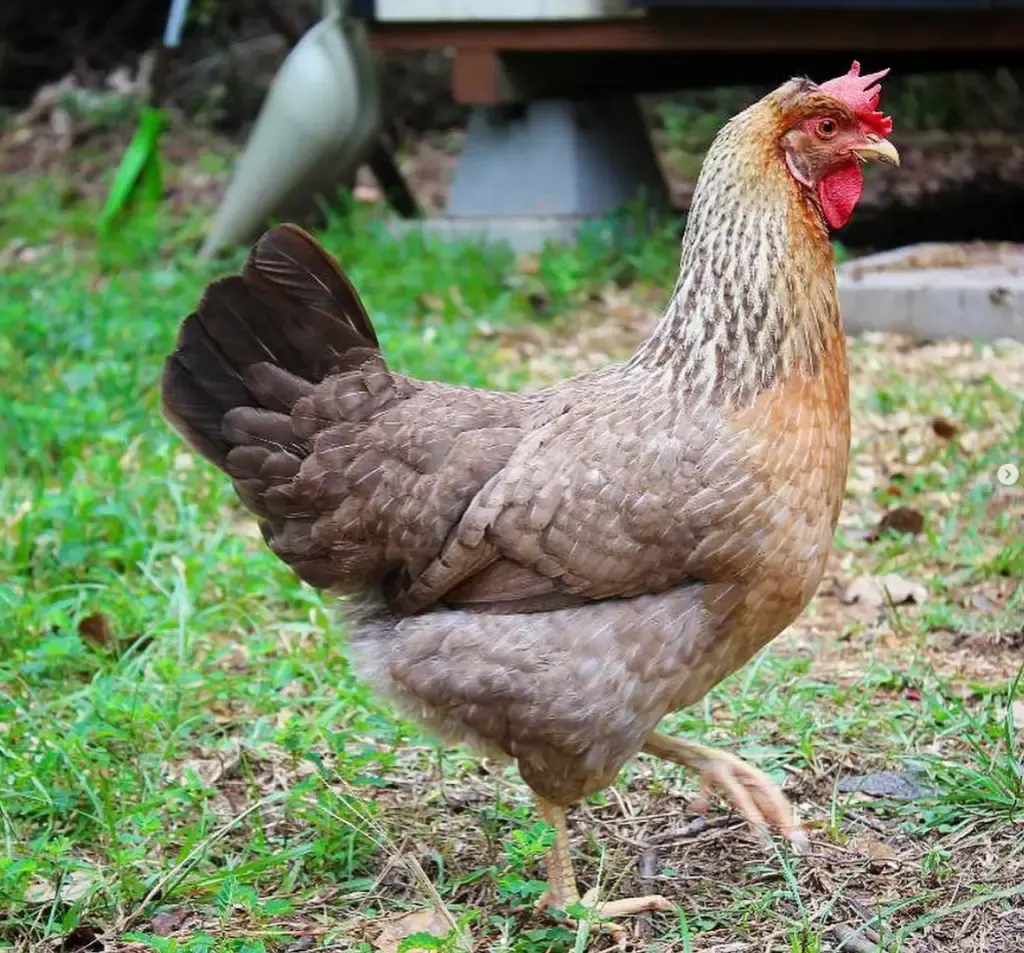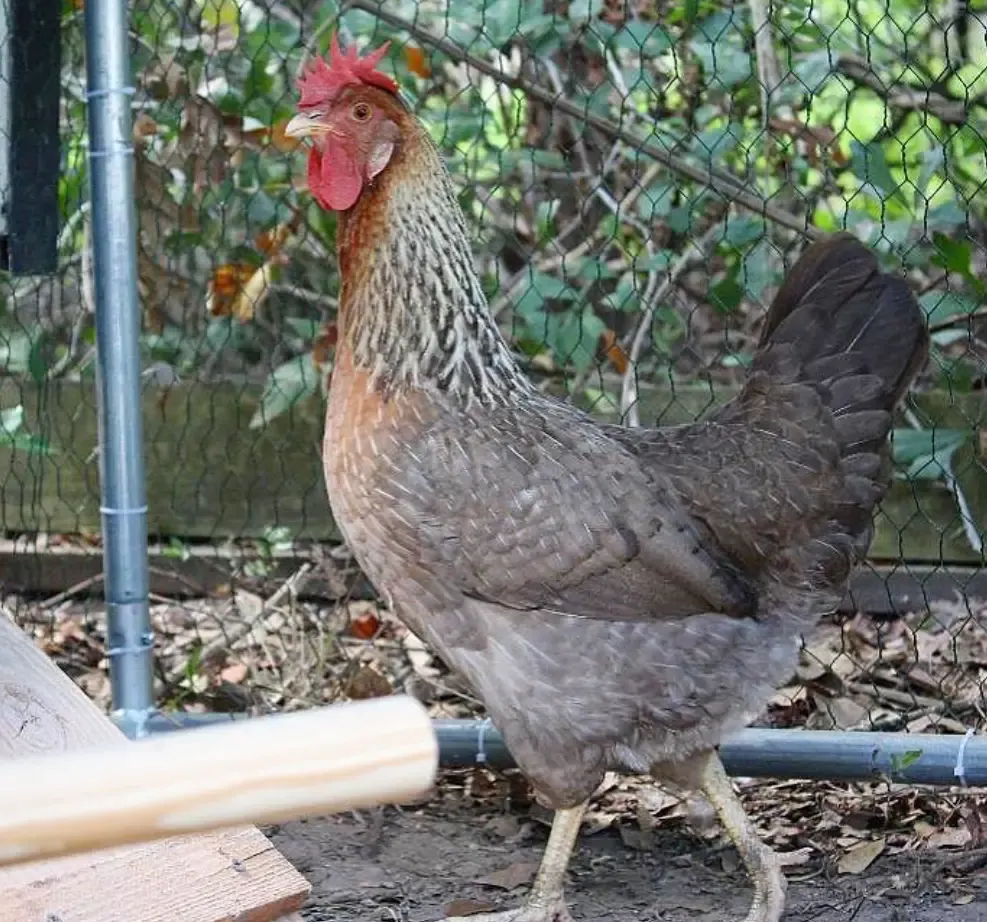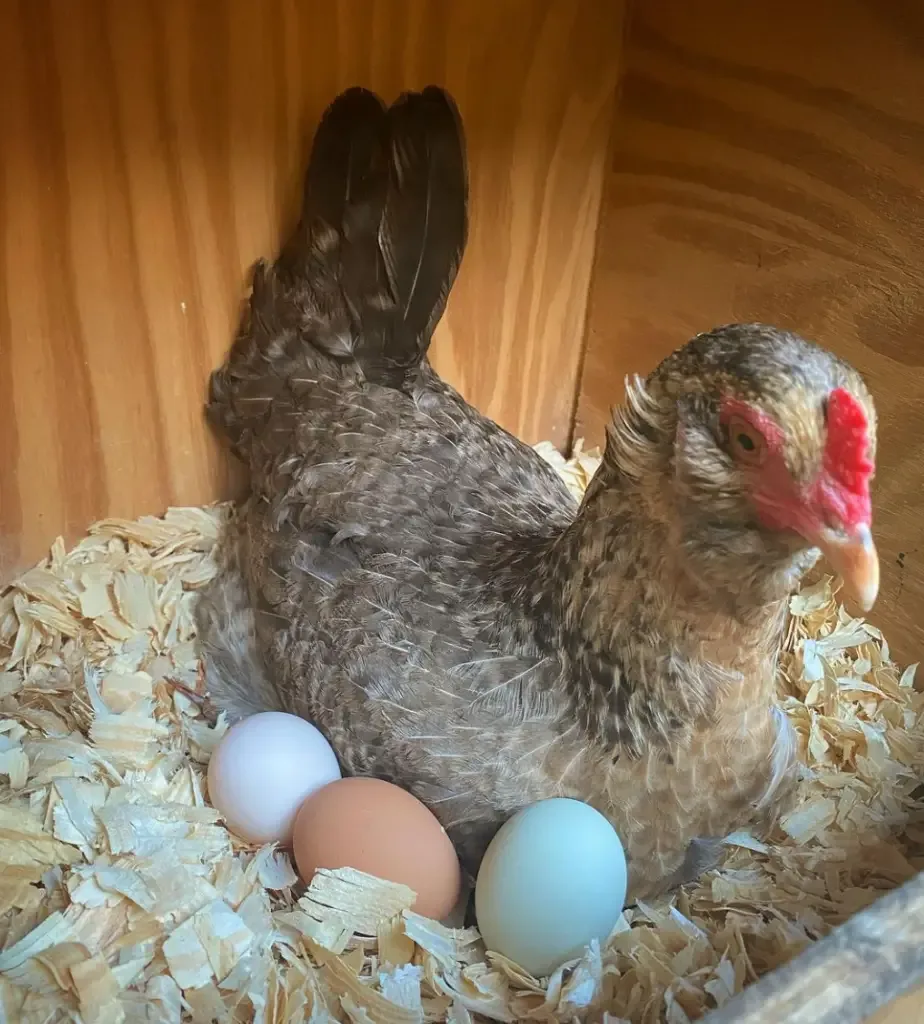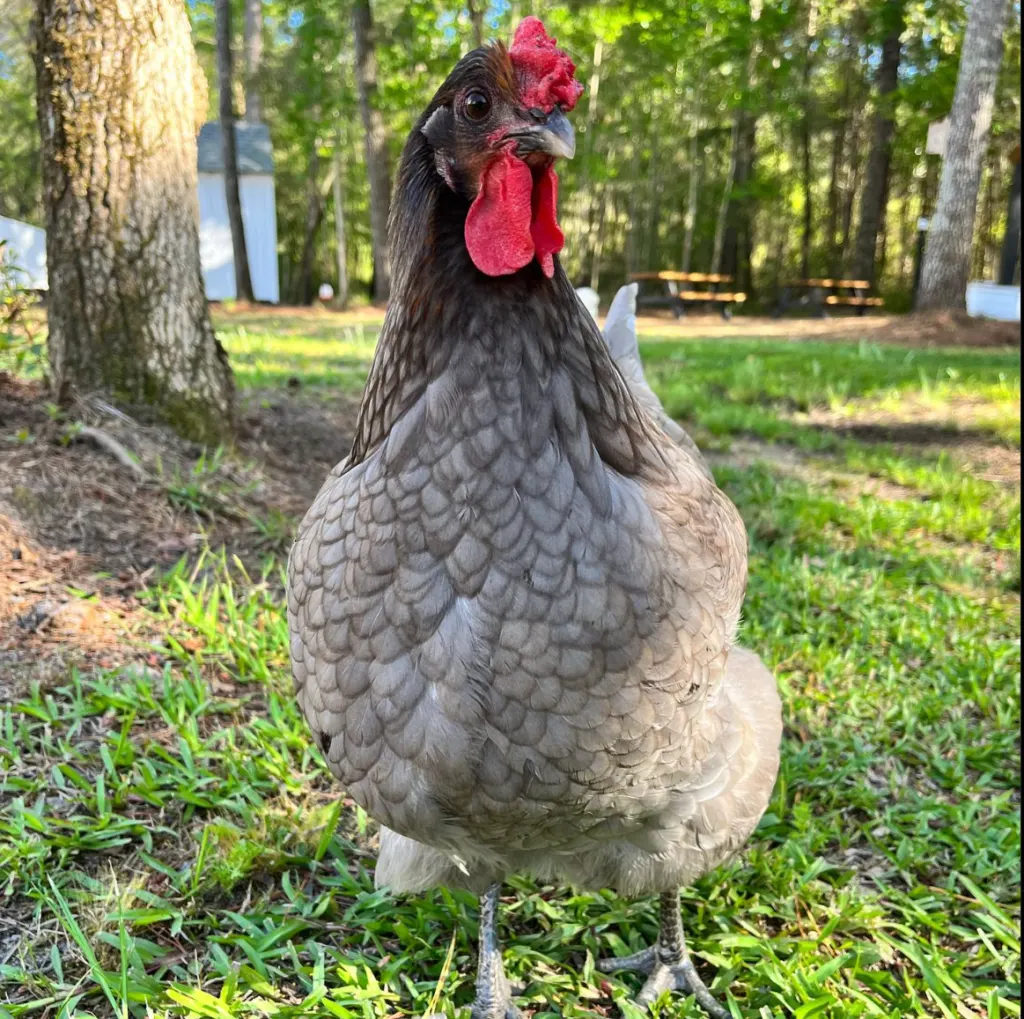The Olive Egger chicken is a unique and popular breed of chicken that is becoming increasingly popular among chicken enthusiasts.
These birds are known for their beautiful green and blue eggs, which come from a cross between a dark brown egg-laying breed and a blue egg-laying breed.
Oliver Egger chickens all look slightly different due to their hybrid nature, however, they are all beautiful and make great additions to any backyard flock.
In this article, we will discuss:
- What Olive Eggers are and why they are so popular
- Their history and an overview of the breed
- Olive Egger’s temperament and physical appearance
- Olive Egger chicken care and requirements
- And some frequently asked questions

Olive Egger Chicken Overview
| Lifespan | 5-8 years |
| Weight | Hen: 4 – 6 lbs, Rooster: 6 – 7 lbs |
| Appearance | Varies based on parent breeds |
| Egg Color | Olive green, but can also be blue or even pink |
| Egg Size | Medium to large |
| Egg Production | 150-200 eggs per year (3-4 per week) |
| Broodiness Level | Varies based on parent breeds |
| Beginner Friendly | Yes |
| Space Needed | 4 square feet inside the coop, 10 square feet outside |
| Price | $4-$9 per chick |
What Are Olive Egger Chickens?
Olive Egger chickens are a popular hybrid breed known for their unique green eggs.
They are not a recognized breed by the American Poultry Association, but instead a cross between a blue egg layer (such as an Ameraucana or Araucana) and a dark brown egg layer (such as a Maran or a Welsummer).
The resulting offspring are known as Olive Eggers, and they have a wide range of feather colors and patterns.
Some may have a more greenish hue to their feathers, while others may have a more brownish tone. But some can also have a dusty blue or gray appearance.
Olive Eggers are beloved for their sweet disposition and make great companions and egg producers.
While hybrid chickens are not as predictable as purebred chickens, Olive Eggers are worth seeking out for many keepers.
They are a little harder to come by, but their beautiful olive-green colored eggs and docile nature make them a desirable addition to any flock.
Why Are Olive Egger Chickens So Popular?
One of the main reasons why Olive Egger chickens are so popular is because of their unique egg color.
Their eggs range from a light greenish-blue to a darker olive-green color, hence the name “Olive Egger.”
In addition to their beautiful eggs, Olive Egger chickens are also known for their friendly and docile personalities.
They are great for families with children or for those who want a backyard chicken that is easy to handle and care for.
Olive Eggers also do well in many different temperatures and climates, making them very adaptable chickens that can live almost anywhere.

Olive Egger Chicken History
Olive Egger chickens are not a breed, but a hybrid of two different breeds.
The origin of Olive Egger chickens results from crossbreeding between a blue egg-laying breed, such as an Araucana or Ameraucana, and a dark brown egg-laying breed, such as a Maran or Welsummer.
This crossbreeding results in offspring that lay beautiful olive-colored eggs, hence the name Olive Eggers.
The craze for multi-colored eggs began in 1842 when a few Chinese chicken breeds were transported to England.
Once in the country, these chickens were crossbred with the local chicken breeds, to the great bemusement of the local farmers.
This phenomenon made farmers experiment with crossing different varieties with specific traits.
The hybridization of chicken breeds has been a common practice for centuries, with the aim of creating a bird that has the best traits of both parent breeds.
Olive Egger chickens are a great example of this. They are a relatively new hybrid breed that was created to satisfy the demand for unique and colorful eggs.
The breeding of Olive Egger chickens is not an exact science, and the offspring of different crosses can vary in appearance and egg-laying abilities.
However, these chickens are generally hardy and easy to care for, making them a popular choice among backyard chicken keepers.
Physical Characteristics of Olive Egger Chickens
Olive Egger chickens are a unique and interesting breed that can have a variety of physical characteristics.
Olive Eggers are produced by breeding a brown egg layer with a blue egg layer.
Here are some parent breed options for breeding Olive Eggers:
Brown egg layers:
- Marans
- Barnevelder
- Welsummer
- Empordanesa
- Penedesenca
Blue egg layer:
- Araucana
- Ameraucana
- Cream Legbar
As you can see, there are many different parent breed options to produce Olive Eggers.
Because of this, their size, weight, and appearance can vary depending on the breeds they are crossed with.
Size and Weight
Olive Egger chickens are generally medium-sized birds.
They can weigh anywhere from 4 to 7 pounds when fully grown.
However, their size and weight can vary depending on the breeds they are crossed with.
Color and Appearance
Olive Egger chickens are known for their unique coloration.
They can come in various colors, ranging from black, brown, and gray to white, cream, and buff.
Their feathers can also have different patterns, such as stripes, speckles, and spots.
Additionally, Olive Eggers can have certain physical characteristics that are inherited from their parent breeds, such as tufted ears, feathered legs, and beards.
When it comes to egg color, Olive Eggers lay eggs that are usually shades of green or olive.
However, the exact color can vary depending on the genetics of the bird. Some Olive Eggers may lay eggs that are more brown or blue in color, depending on the breeds they are crossed with.

Olive Egger Temperament
Although Olive Egger’s temperament varies on the parent breeds, they are typically considered docile and friendly.
In general, they are well-mannered and easy to handle, making them a great choice for families with children and other pets.
These birds are also fairly active and love to forage and free range.
In addition, they adapt well to all different kinds of climates, which make them very versatile to different temperatures and environments.
These chickens are often described as:
- Docile
- Friendly
- Easy-going
- Active
- Chatty
However, Olive Egger’s temperaments can vary depending on the breeds of their parents.
For instance, Olive Eggers with a Welsummer parent may be more friendly and intelligent while a Maran parent may be more independent and skittish.
The level of broodiness also depends heavily on the parent breeds.
Overall, this breed is kind and fairly low-maintenance.
Egg Laying
The Olive Egger chicken is known for its egg-laying abilities by producing eggs with beautiful shades of green and olive.
However, it is not guaranteed that an Olive Egger will produce green eggs.
They are also known to lay dark brown, blue, or pink-colored eggs.
However, hens will always lay the same color egg throughout her lifetime and you won’t be able to tell what color egg she will lay until she actually begins laying.
Olive Egger chickens will start laying their first eggs when they reach maturity at around five to six months old.
They can lay between 150-200 eggs per year, which is about 3-4 eggs per week.
Their egg size is medium to large, with a weight of around 55-60 grams per egg.
Although their eggs come in a wide range of colors on the outside, they all taste the same and have the same nutritional value on the inside.
Not to mention, they look beautiful sitting out on the counter!

How to Care for Olive Egger Chickens
Caring for Olive Egger chickens is relatively easy and straightforward.
They require the same basic needs as any other chicken, such as a clean coop, fresh water, and a balanced diet.
One thing to keep in mind is that Olive Egger chickens are a hybrid breed, which means that their traits can vary widely.
Some may have a stronger immune system or be more resistant to certain diseases than others. It’s important to observe your chickens and take note of any changes in behavior or health.
Here are some tips on how to care for Olive Eggers:
Feeding
No matter the breed, most chickens require a balanced diet consisting of high-quality commercial feed and access to fresh water.
They should be on a high-quality chick starter from the time they hatch until around 16 weeks of age.
At maturity (16 weeks and older), Olive Eggers will need to transition to a complete layer feed to meet their nutritional needs.
You can also supplement with some treats such as:
- Fruits
- Vegetables
- Mealworms
- Black fly larvae
- Crushed eggshells
- Crushed oyster shells
- Seeds
- Chicken grit
- Other high-protein sources
Adding extra protein and calcium to their diet will help them to lay eggs with strong eggshells.
Make sure to research before giving them any type of snack, treat, or table scrap to make sure it is safe for them to eat.
Here are a few fruit and vegetable options they can safely consume in moderation:
- Watermelon
- Pinneaple
- Plums
- Celery
- Kiwi
- Green beans
- Berries
- Cucumber
- Cabbage
- Lettuce
It’s important that their diet consists of mostly commercial feed with only 10%-20% of their diet being snacks and table scraps.
Olive Eggers also enjoy foraging and will appreciate being able to free-range to get some additional vitamins and minerals in the yard.

Coop Setup and Care
Like with other chickens, Olive Egger chickens require ample space both inside the coop and outdoors in order to thrive.
Their coop size will depend on how many birds you decide to keep and each chicken will need their own space to remain happy and healthy.
An overcrowded coop can lead to a number of issues such as bullying, aggression, and the spreading of diseases.
Each adult Olive Egger chicken requires 4 square feet inside their coop.
It’s also a good idea to provide perching spaces as well as one nesting box per 4-5 hens.
If you plan to have them outside in a run during the day, each Olive Egger will need 10 square feet of space per bird.
It’s important that their coop is covered and secure to protect them from predators and the elements.
Free Ranging
Olive Egger chickens are fairly active birds and love to have ample space to free-range outside of the coop.
As stated above, each Olive Egger chicken requires 10 square feet of space while free-ranging.
Health Concerns
Olive Egger chickens are hardy birds that typically resist common chicken health concerns such as coccidiosis or fatty liver hemorrhagic syndrome.
The most common health issue to watch out for is mites and lice.
These parasites will spread very rapidly if not taken care of immediately.
It’s important to give your birds daily checks to ensure they remain healthy and parasite free.
If your chickens become itchy and lethargic or lose their appetite and drop their egg production, it usually indicates something is wrong and your chicken may have mites or lice.
Diarrhea is another common symptom that chickens can get for a few different reasons.
If you notice one or multiple of your birds have diarrhea, it’s important to make sure they have constant access to clean drinking water to help them rehydrate.
It’s also important to make sure they are limited on how many treats and table scraps they are eating every day.
If these symptoms continue, contact your local veterinarian.

Final Thoughts
Olive Egger chickens are a unique and popular breed that are loved for their beautiful eggs and friendly personalities.
They are easy to care for and make great pets for families or backyard chicken enthusiasts.
Additionally, they lay eggs that are usually shades of green or olive, making them a popular choice for backyard chicken keepers who want to add some color to their egg baskets.
If you’re considering adding Olive Eggers to your flock, be sure to do your research and find a reputable breeder to ensure that you’re getting healthy and well-cared-for birds.
Still not sure? Keep reading below for some frequently asked questions.
FAQs
Are Olive Eggers good egg layers?
Yes, Olive Egger chickens are excellent egg layers.
They lay around 150-200 medium to large eggs per year, which is 3-4 eggs per week.
What are Olive Eggers mixed with?
Olive Eggers are hybrid breeds that are produced by mixing a blue egg-laying breed (like an Araucana or Ameraucana) and a dark brown egg-laying breed (like a Maran or Welsummer).
When do Olive Eggers start laying?
Olive Egger chickens start laying eggs when they are around 16 weeks old.
However, some may start laying before or after the 16-week mark.
It strongly depends on the parent breeds that the Olive Egger comes from.
What is the difference between an Easter Egger and an Olive Egger?
Easter Eggers are chickens that are described as laying a range of different colored eggs such as pink, blue, or green.
Olive Eggers are a type of Easter Egger that typically only lay olive green eggs.
What is a Sapphire Olive Egger?
Sapphire Olive Eggers are a type of Olive Egger chicken that have dusty blue, gray, or lavender feathers and lay olive green eggs.
They have very similar traits to a regular Olive Egger chicken.

